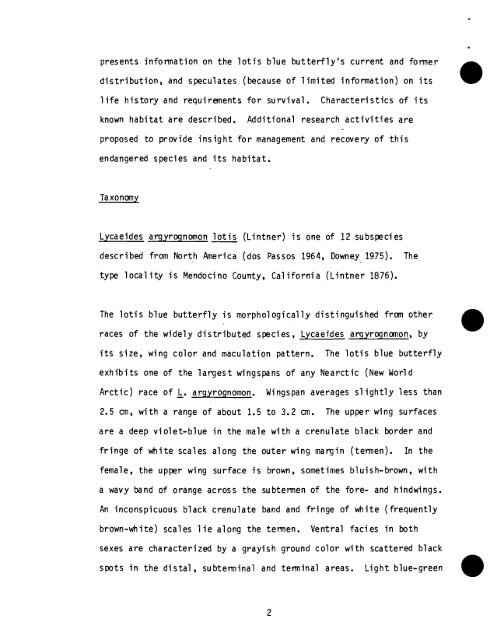Lotis Blue Butterfly Recovery Plan - U.S. Fish and Wildlife Service
Lotis Blue Butterfly Recovery Plan - U.S. Fish and Wildlife Service
Lotis Blue Butterfly Recovery Plan - U.S. Fish and Wildlife Service
You also want an ePaper? Increase the reach of your titles
YUMPU automatically turns print PDFs into web optimized ePapers that Google loves.
presents. information on the lotis blue butterfly's current <strong>and</strong> former<br />
distribution, <strong>and</strong> speculates (because of 1 imi ted information) on its<br />
life history <strong>and</strong> requirements for survival. Characteristics of its<br />
known habitat are described. Additional research activities are<br />
proposed to provide insight for management <strong>and</strong> recovery of this<br />
endangered species <strong>and</strong> its habitat.<br />
Ta xonomy<br />
Lycaeides argyrognomon lotis (Lintner) is one of 12 subspecies<br />
described from North America (dos Passos 1964, Downey 1975). The<br />
type 1 ocal i ty is Mendoci no County, Cal iforni a (Lintner 1876).<br />
The loti s blue butterfly is morphologically distinguished from other<br />
races of the widely distributed species, Lycaeides argyroqnomon, by<br />
its size, wing color <strong>and</strong> maculation pattern. The lotis blue butterfly<br />
exhibits one of the largest wingspans of any Nearctic (New World<br />
Arctic) race of - L. argyrognomon. Wingspan averages sl ightly less than<br />
2.5 cm, with a range of about 1.5 to 3.2 cm. The upper wing surfaces<br />
are a deep violet-blue in the male with a crenulate black border <strong>and</strong><br />
fringe of white scales along the outer wing margin (tennen). In the<br />
female, the upper wing surface is brown, sometinies bl uish-brown, with<br />
a wavy b<strong>and</strong> of orange across the subtermen of the fore- <strong>and</strong> hindwings.<br />
An inconspicuous black crenulate b<strong>and</strong> <strong>and</strong> fringe of white (frequently<br />
brown-white) scales 1 ie along the termen. Ventral facies in both<br />
sexes are characterized by a grayish ground color with scattered black<br />
spots in the distal, subterminal <strong>and</strong> terminal areas. Light blue-green<br />
I

















